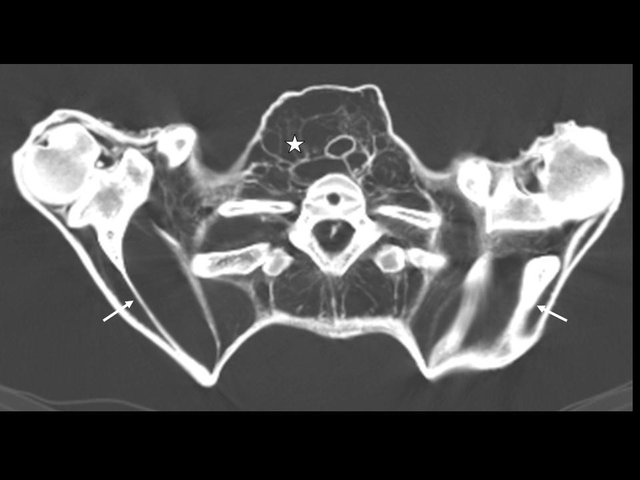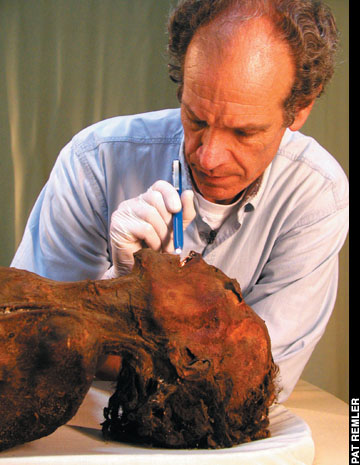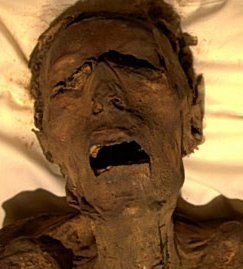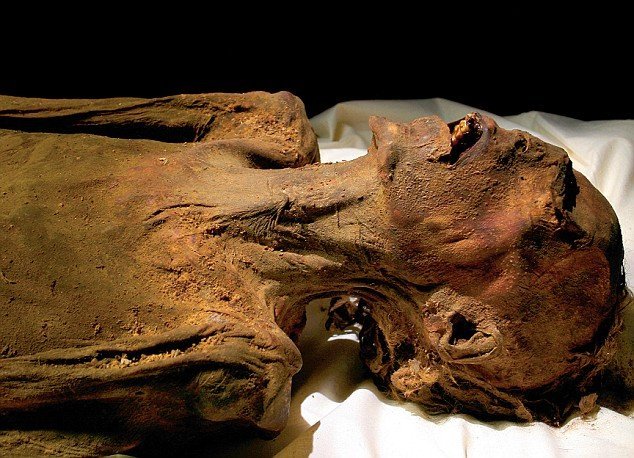This Mummy Monday let’s talk about another mummy found in the Deir el Bahri cache, Unknown Man E. The identity of this mummy is not known, though there are a couple of theories. The most prominent theory is that this mummy is a Prince from the New Kingdom, who may have been involved and tried in a harem conspiracy.
Because we are not entirely sure who this mummy was, I am going to talk about the mummy first and then the theories as to who this mummy may be!
Coffin
The mummy was buried in a white simple Osiriform coffin (CG 61023) that was completely undecorated or labeled. It lacked any features to help date the coffin or identify the owner. The crossed arms on the coffin were popular in the 19th dynasty and onward, but the simple headdress dates to the earlier 18th dynasty. It was made out of expensive cedar wood, indicating whoever owned it was well off. The coffin and the mummy had seemingly not been rifled through by thieves.

Besides the mummy, two canes were found in the coffin. They were made out of braided reeds. Egyptologist Geoffrey Martin noted that the treasurer of Tutankhamun, a man named Maya, had been depicted in his tomb with two canes. Unfortunately, the canes current location has not been found.
Mummy
As I mentioned this mummy was found in the Dier el-Bahri cache (DB 320), which we have talked about several times. I’ve already posted about Nodjmet and Seqenrene Tao, who were also found in this cache.

The mummy we are focusing on has been labeled as Unknown Man E (CG 61098). He was about 18 to 24 years old at the time of his death. After the discovery of the cache in 1881, the mummy was transported back to Cairo where it was first unwrapped on June 6, 1886, by Gaston Maspero.

The first thing that everyone notices about the mummy is the internal scream that the face is locked in. This mummy has often been referred to as “The Screaming Mummy.” Unfortunately, this has led a few Egyptologists to assume he died a painful death, but more on that later.
The body was found wrapped in sheepskin, which for the Egyptians was a ritually unclean object. The sheepskin still has some of the original white wool attached. Beneath this were layers of thick linen, dating to the 18th dynasty, and a layer of natron salts which were applied to the final layers of the bandages. This natron had absorbed fat from the body and emitted a strong putrid odor when unwrapped. The bandages that covered that layer were impregnated with an adhesive and could only be removed with a saw, which would have destroyed any inscriptions that were on the bandages (if there were any).
It was originally believed that his hands and feet were found bound, but this could have been misinterpreted. Apparently, the bandages were held in place around the upper wrists and lower legs with knotted lengths of linen. They were tied extremely tightly because they left a definitive imprint on the skin on the upper arms. There is the possibility that the arms and legs were tied down because rigor mortis, or the stiffening of the joints and muscles of a body a few hours after death, had already set in by the time the body was mummified.

Underneath this layer was a coating of natron salt, crushed resin, and lime, which most likely consisted of calcium oxide. This was applied directly to the skin, covered the whole body, and was extremely caustic. After this was removed by Maspero and his team, they found the body of the young man. They noted that the muscles of his abdomen were extremely constricted and that his organs were still inside his body, going against all Egyptian mummification traditions. His penis was still intact but was missing when G.E. Smith examined the mummy a quarter-century later.
Gold earrings were found in his pierced ears. They were in the shape of hollow tubes “tapered at both ends and bent back to form an ellipse.” Like the canes found in the coffin, the earrings’ current location cannot be found.

Check out this image to the right and this video below to see a possible reconstruction of the face of Unknown Man E. The video also features one of his missing earrings!
Theories About the Mummy’s Death
When examining the mummy, Maspero had been convinced that there was foul play.
“All those who saw him first hand thought that [he] looked as though he had been poisoned. The contraction of the abdomen and stomach, the desperate movement with which the head is thrown back, the expression of excruciating pain spread over the face hardly allow for any other explanation.”

Daniel Fouquet, a physician who examined the mummy, was convinced that the mummy had died of poison, stating,
“…the last convulsions of horrid agony can, after thousands of years, still be seen.”
This seems to be based on the constriction of the abdomen. But this may be a reaction to the preservative chemicals that were placed on his skin. That substance would have sucked out all the moisture from his skin, which then would have made his internal organs shrink and thus constrict the skin of the abdomen. But one fact that may support poison is that there was no food found in his stomach which could indicate that he vomited everything up after ingesting the poison.

A chemist named Mathey said this,
“the wretched man must have been deliberately asphyxiated–most likely by being buried alive.”
The buried alive theory seems to have been mostly attributed to the bound hands and feet and the horrible scream on the face. This is a theory that many believed in the early 1800s and 1900s and from what I know, I don’t believe there is evidence of any Egyptian being buried alive.
Some have also posed that he was impaled because his perineum was found badly torn. But this was unlikely because his large intestine was found undamaged, so the anal injury must have been post-mortem.
G.E. Smith dismissed these previous theories, saying,
“a corpse that was dead of any complaint might fall into just such an attitude as this body has assumed.”
It has been assumed that many of the earlier theories of his death were simply based on the mummy’s facial expression. Several other mummies are locked into this silent scream, which can mostly be attributed to rigor mortis, lockjaw, or the mummification method.
Theories About the Mummy’s Identity
There is very little known about who this mummy was in life, but based on the mummification techniques, there are a few theories, though only one (besides the theory of Maya, Tutankhamun’s treasurer), has a named Egyptian attached to it. Although this is one of the first theories, I’m going to talk about it last.
One of the theories is that this mummy was the unnamed Hittite prince that was sent by his father to marry Ankhsenamun, the widow/sister of King Tutankhamun. According to preserved documents, this prince was murdered on the way to Egypt. But why wasn’t he sent back to the Hittites?
One of the more important pieces of evidence for the identity of this mummy lies in the sheepskin laid on top of the body. As I mentioned, sheepskins were seen as ritually unclean by the ancient Egyptians. By why would an Egyptian noble or a Hittite prince buried in Egypt be buried with a sheepskin? Some scholars have looked at a reference is the story of the Tale of Sinuhe. In this story, the pharaoh tries to convince Sinuhe, a former friend and confidant who has been living abroad, to return to Egypt. The king says,
“You shall not die in a foreign land…you shall not be placed in a sheepskin as they make your grave.”
This implies that placing a sheepskin over a body was a non-Egyptian tradition.
This led some scholars to believe that this mummy was an important Egyptian governor or dignitary who had died abroad, possibly in an Egyptian outpost in Palestine. They speculate that maybe he died in the desert while hunting and his body was not found immediately. This would attribute to the rigor mortis that had set in and made it difficult for his body to fit in the coffin. Then his body would have been prepared by non-Egyptian embalmers, which was why the mummification was not consistent with Egyptian traditions. The sheepskin, possibly an Asiatic burial tradition, and the use of the calcium oxide mixture on the skin, which points to a Greek influence, are the two foreign features. The official may have already had the coffin prepared (since he might have been in a location where cedar wood was more accessible), but it had not been painted or inscribed with the vital texts. So they sent the mummy and the body back to Egypt.
The Egyptian officials who received it may have noticed the sheepskin and found it offensive, so they just immediately buried the coffin. Based on the location in the DB cache, the mummy was probably originally buried in the Valley of the Kings or somewhere close by. This location is probably true no matter what the identity of the mummy is.
An Answer to His Identity?
Maspero was the first to propose that this was the mummy of Pentawer, a prince of the 20th dynasty involved in a harem conspiracy that led to the death of his father. Maspero determined that the contorted expression, the organs not being removed, the tightly bound wrappings, the taboo sheepskin, and the undecorated coffin were all done to stop this person from entering the afterlife.

This theory was revived by Egyptologist Bob Brier, who was able to examine the mummy after it hadn’t been seen for almost 100 years. He also concluded that it was most likely the body of Pentawer.

Most importantly, the DNA of Ramesses III (who funnily enough was also buried in the DB 320 cache) and Unknown Man E were compared. They both shared paternal Y-DNA haplogroup E1b1a and half of their DNA, which means that they were most likely father and son. Ramesses III had at least seven sons, most of which mummies have been found, so there is a small chance that this mummy could have been another one of his minor sons.

You can check out this article by Zahi Hawass and others which studied the bodies of Ramesses III and Unknown Man E, thus helping connect them.
Who was Pentawer?
Pentawer, also known as Pentawere or Pentaweret, was the son of Pharaoh Ramesses III and his secondary wife Tiye (not related to the wife of Amenhotep III and mother of Akhenaten, also called Tiye). All we know of this prince comes from the documents related to the harem conspiracy.

Interestingly the actual name of the prince is not known; this was just the name that was given to him in the Judicial Papyrus of Turin. This papyrus contains the records of the harem plot that he might have been involved in.
Harem Plot
The Judicial Papyrus of Turin is a combination of papyri in the Egyptian Museum in Turin that all describe the trial of those accused on the harem plot to kill Ramesses III. These papyri were separated by a thief to sell them. Luckily when they separated it, they did not damage the text. Papyrus Rollin, Papyrus Varzy, Papyrus Lee, Papyrus Rifaud, and Papyrus Rifaud II are all included in this collection.

According to the Judicial Papyrus of Turin, Pentawer’s mother Tiye may have initiated a harem conspiracy to assassinate the pharaoh and put her son on the throne, even though the next in line to the throne was the son of Tyti. This plot was unfortunately not foiled as Ramesses III was most likely assassinated by having his throat slit on the 15th day of the third month of Shemu in 1155 B.C.E. This was the day of the Beautiful Feast of the Valley, which caused quite a commotion in the palace and harem in Medinet Habu, which was to provide cover for the assassination. Pebekkamen, a court official and one of the main conspirators, received help from a butler named Mastesuria, the cattle overseer Panhayboni, overseer of the harem Panouk, and clerk of the harem Pendua.

It was once thought by Egyptologists that Ramesses III may have survived the attack, but recent CT scans on his mummy reveal a different story. His throat was cut so severely that it severed the trachea, esophagus, and hit his neck bones. This means it was probably immediately fatal. Check out this video about recent CT examinations that helped determine these new clues.

But they were unable to put Pentawer on the throne because there were too many officials still loyal to Ramesses III and his heir Ramesses IV. The new king selected 12 magistrates to investigate and judge the cases across five trials. Accusations were brought up against Tiye, Pentawer, men in charge of the harem, women from the harem, and military and civil officials.
This is a translation from a portion of the Judicial Papyrus,
“Pentawere, to whom had been given that other name. He was brought in because he had been in collusion with Teye, his mother, when she had plotted the matters with the women of the harem concerning the making rebellion against his lord. He was placed before the butlers in order to be examined; they found him guilty; they left him where he was; he took his own life.”
Check out this link to an entire book about the Harem Conspiracy by Susan Redford and check out the article below to read the Judicial Papyrus of Turin.
Pentawer may have been an unfortunate pawn in this conspiracy. And since he was a noble, he may have been given the option of killing himself by poison to be spared the alternative. 28 people were executed, meaning that they burned alive and their ashes were strewn in the streets, which would ruin their chances for the afterlife. Others like Pentawer were given the choice to kill themselves, while others had their ears and noses cut off. The punishment for Queen Tiye is not included.
The likelihood that Unknown Man E was the Prince Pentawer has gained enough traction to be more than likely. But I do appreciate the thorough study of the mummification method which concluded that this was a foreign dignitary mummified abroad. I think a lot of the unique features of the mummification method could be attributed to that, which is why I question why they (mostly the calcium oxide mixture) would be used if this was the body of Pentawer.
Sources
https://en.wikipedia.org/wiki/Pentawer
https://archive.archaeology.org/0603/abstracts/mysteryman.html
https://anubis4_2000.tripod.com/UnknownManE/ManE.htm
https://www.livescience.com/61749-screaming-mummy-backstory.html
https://en.wikipedia.org/wiki/Harem_conspiracy
https://en.wikipedia.org/wiki/Judicial_Papyrus_of_Turin
https://ib205.tripod.com/unknown_man.html
Image Sources
Mummy – Wikimedia Commons – G Elliot Smith
Hieroglyphs of his name – Wikipedia Article
Bob Brier with mummy, with Zahi Hawass, and drawing of the discovery of DB320 – Pat Remler
The mummy, reconstruction, and coffin – The Theban Royal Mummy Project
Mummy of Ramesses III – Wikimedia Commons – G Elliot Smith
Judicial Papyrus of Turin – Wikimedia Commons – Khruner
Hawass, Unknown Man E, and Ramesses III – http://ambassadors.net/archives/issue34/selected_studies3.htm
Coffin Image – https://blog.selket.de/tag/pentawer






One comment